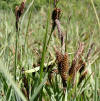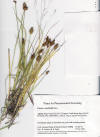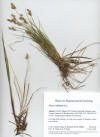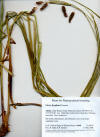|
Carex amplifolia Nevada. Toiyabe Range, SE of Austin along FS Rd 003, 5.3 mi S of Hwy 50, T18N R44E Sec 5,; 39º25.464, 117º02.770, 7000 ft. Meadow with high density stands of Veratrum californicum in valley running SE bordered by a closed canopy aspen forest and sagebrush on drier slopes. Shrub thickets include Rosa nutkana, Symphoricarpos oreophilus; and forbs Iris missouriensis, 10 July 2009.
|
||
|
Carex buxbaumii |
Carex buxbaumii |
Carex crawfordii
|
|
Carex echinata
|
Carex lyngybaei |
Carex lyngybaei
|
|
Carex lyngybaei
|
Carex saxatilis
|
Carex utriculata |
|
Fiorentino A., B. D'Abrosca, S. Pacifico, A. Natale and P. Monaco. 2006. Structures of bioactive carexanes from the roots of Carex distachya Desf. Phytochemistry 67(10): 971–977. “Four metabolites, named carexanes I-L, have been isolated from the roots of Carex distachya Desf, an herbaceous plant living in the Mediterranean maquis, together with three known compounds, already isolated from the aerial part of the plant. All the compounds have been characterized on the basis of their spectroscopic properties. Carexane I derived from the lose of a proton from the C-18 carbon of an intermediate isopropyl cation. Its stereostructure has been elucidated by Mosher's method, NOESY/ROESY experiments and computational calculations. The bioactivity on seed germination and root/shoot growth of Lactuca sativa L. of all the isolated compounds is also reported.”
|
||






